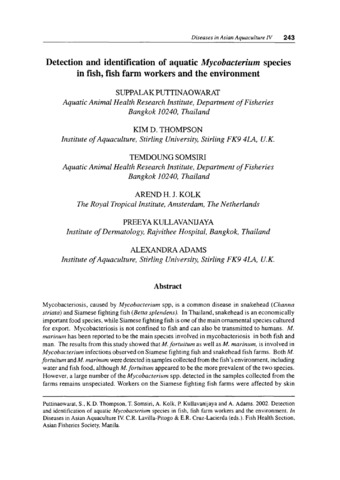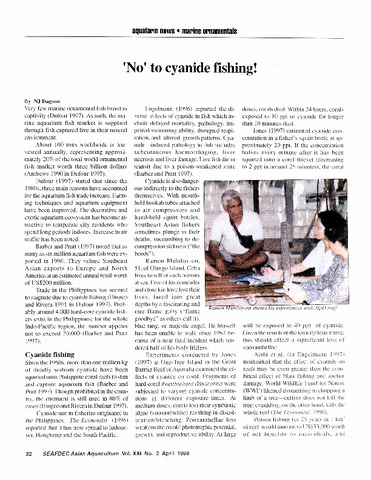Detection and identification of aquatic Mycobacterium species in fish, fish farm workers and the environment
- Global styles
- MLA
- Vancouver
- Elsevier - Harvard
- APA
- Help

ดู/เปิด
วันที่
2002ผู้เขียน
Page views
319ASFA keyword
AGROVOC keyword
Taxonomic term
เมตาดาต้า
แสดงระเบียนรายการเต็มShare
นามธรรม
Mycobacteriosis, caused by Mycobacterium spp, is a common disease in snakehead (Channa striata) and Siamese fighting fish (Betta splendens). In Thailand, snakehead is an economically important food species, while Siamese fighting fish is one of the main ornamental species cultured for export. Mycobacteriosis is not confined to fish and can also be transmitted to humans. M. marinum has been reported to be the main species involved in mycobacteriosis in both fish and man. The results from this study showed that M. fortuitum as well as M. marinum, is involved in Mycobacterium infections observed on Siamese fighting fish and snakehead fish farms. Both M. fortuitum and M. marinum were detected in samples collected from the fish s environment, including water and fish food, although M. fortuitum appeared to be the more prevalent of the two species. However, a large number of the Mycobacterium spp. detected in the samples collected from the farms remains unspeciated. Workers on the Siamese fighting fish farms were affected by skin lesions, while those on snakehead fish farms were not unaffected. When biopsies of the lesions were analysed by polymerase chain reaction and reverse cross blot hybridisation, M. fortuitum together with unspeciated Mycobacterium sp. appeared to be the main aetiological agents associated with the lesions.
การอ้างอิง
Puttinaowarat, S., Thompson, K. D., Somsiri, T., Kolk, A. H. J., Kullavanijaya, P., & Adams, A. (2002). Detection and identification of aquatic Mycobacterium species in fish, fish farm workers and the environment. In C. R. Lavilla-Pitogo & E. R. Cruz-Lacierda (Eds.), Diseases in Asian aquaculture IV: Proceedings of the Fourth Symposium on Diseases in Asian Aquaculture, 22-26 November 1999, Cebu City, Philippines (pp. 243-256). Fish Health Section, Asian Fisheries Society.
Type
Conference paperISBN
9718020160คอลเลกชัน
Related items
Showing items related by title, author, creator and subject.
-
'No' to cyanide fishing!
Dagoon, N. J. (Aquaculture Department, Southeast Asian Fisheries Development Center, 1999) -
The Philippine industry: Marine tropical fish
Castaños, Milagros T.; Southeast Asian Fisheries Development Center, Aquaculture Department (Aquaculture Department, Southeast Asian Fisheries Development Center, 1992) -
CRM in the Philippines: Lessons learned
Southeast Asian Fisheries Development Center, Aquaculture Department (Aquaculture Department, Southeast Asian Fisheries Development Center, 1996)Philippine coastal communities can become capable fishery resource managers and that their management practices can become largely self-sustaining if the project approach focuses on assisting fishermen to learn how to help ...





